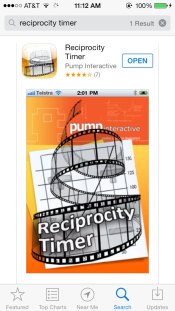I think in terms of EV values, that way one can work in either f/stop changes or shutter speed changes, or use them in combination. That's
why many convenient meters, such as the Pentax spotmeters used by many of us as well as the cine industry, give EV values. In the field, I
often don't have time to dig out some silly smart phone and punch a bunch of app buttons reliant on a half-dead battery to tell me what to do.
The old-fashioned way is a hundred times faster and far more reliable.
The smartphone tool is just like the spot meter tool, it tells you things, you could do it without the spot meter, but why not use the tools you have.
Also, half dead battery... I think not, my iPhone (with mophie case I'll admit to having) will last 2 days with antenna, if I shut that off to work in the field I could easily go 8 days with it on, if I shut it down when I'm not using it for metering or exposure stuff, I could last longer.
It would take me 20 minutes to work out all the math if I had to figure it out, with the app, I punch in data and it spits out more data, and I use that.
It's no different than a spot meter










